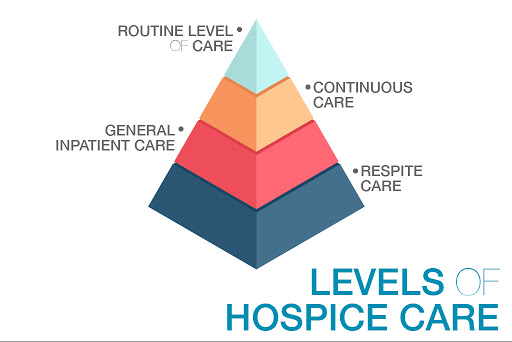What Are the 4 Levels of Hospice Care?

Hospice care is specialized medical care focusing on patients with life-limiting illnesses or health conditions. This type of health care addresses a patient’s emotional, social, physical, and spiritual needs. Here are the four levels of hospice care:
1. Routine Care
Workers provide routine care in a patient’s home or the place where they reside, like an assisted living facility or memory care. This type of care includes regular visits from a hospice nurse, social worker, or aide. Routine care can entail symptom management, pain management, and emotional counseling for patients and their families.
Some hospice providers can offer nutritional services, assistance with daily tasks, and therapeutic services. You can also get medication, diagnosis-specific equipment, and supplies. A routine care plan can depend on the amount of care you need and your preference.
2. Continuous Care
Continuous hospice care is suitable for patients with a need for palliative care and symptom management. Also called crisis care, a nurse and hospice aide can stay in your home for an extended period to monitor your symptoms. Skilled hospice providers offer continuous care in your residence so you don’t have to stay at the hospital.
If you have a high level of pain, discomfort, and other distressing symptoms, continuous care can help manage these issues. The hospice team can also work with your caregiver or family to provide emotional support.
3. Inpatient Care
If you have acute symptoms that require immediate medical attention, inpatient care can be a suitable option. This type of care can occur in a hospital or nursing facility. Inpatient care can offer support to patients with advanced or complex illnesses. A team of nurses, doctors, chaplains, music therapists, and social workers can be there to address your needs.
You can choose inpatient care for a short period and return home after a certain period of time. Inpatient care is helpful for patients who need long-term support and medical care at the end of their lives. Skilled nurses can administer medical care under a doctor’s guidance and share information with your loved ones throughout treatment.
4. Respite Care
During respite care, workers or family move a patient to an inpatient hospice facility for a temporary stay. This form of care gives caregivers a break from their responsibilities, allowing them to rest and recharge. A hospice team offers reliable care to the patient for a few days and offers counseling services to families.
Hospice respite care can be ideal if a family member needs to attend an event. A hospice provider prearranges and approves respite care. Family caregivers can request respite care more than once, provided they have supporting documentation that their request is valid. A letter of support from a healthcare provider can help you get more respite care days.
Seek the Right Hospice Care Today
You can choose from different levels of hospice care based on your healthcare needs and preferences. If you have a loved one with a terminal illness, these types of care have a holistic approach to care for their well-being. A qualified hospice team can assist with physical symptom management and emotional distress.




